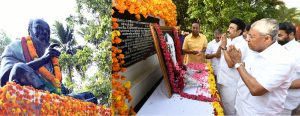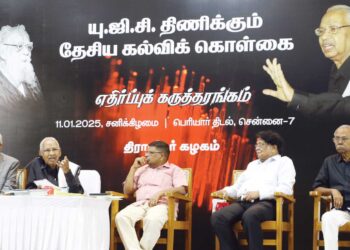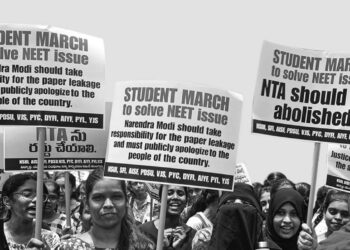FIRST HUMAN RIGHTS AGITATION IN INDIA
V. Kumaresan

The atrocity of treating the toiling class majority as impure filthy humans has persisted for centuries in India. People with their birth-based superiority have been denigrating the majority. This mentality of the self-glorified upper caste people could be perceived by us even today. The Vaikom struggle was the first Human Rights struggle in India, that drew the attention of people all over the country.
Three types of ‘impurity’
The low caste people were considered impure and distanced in three different ways: i) Untouchability, ii) Unseeability and iii) Unapproachability.
The people who glorified themselves as ‘superior’ believed they would be polluted by mere touch of the low caste people. They kept them at a distance at all times and prevented them from coming on the line of their vision. They believed seeing them itself would make them impure. Roads, streets and water sources like wells were believed to become polluted by the use of low caste people. Hence, their approach to those places was prohibited by the upper caste fanatics. Thus, there were untouchability, unseeability and also unapproachability.
Human Rights struggle
Among these three types of ‘impurity’ causing factors, the Vaikom struggle of 1924 – 1925 was a protest against the third category – “unapproachability”. The victory in that struggle scripted history. Vaikom town in Kerala was then under the princely state of Travancore. The low caste people were prohibited from using the streets around the Mahadeva temple in Vaikom. Trespassing was strictly banned for quite a long period.
People with progressive ideals in life started protesting against this social injustice in Vaikom. They were Keralites who took the initiative. Most of them were Congressmen. When they sought the support of Gandhi, he restricted patronage to those agitators. The protest planned was not for temple entry but to enable all the people to use freely the common streets around the temple. And yet, Gandhi refused to support it, calling it interference in religion.
When the agitators tried to fight peacefully and use all the common streets for routine activities, they were arrested and lodged in prisons. The entire struggle was about to be crippled. The leaders of the protest wrote from the prison cells letters to Periyar who was then President of Madras Presidency Congress Committee. They requested him to come to Vaikom and continue the struggle on their behalf. Periyar was busy in Tamil Nadu, undertaking his usual propagation tours. Upon the receipt of the letters, he visited Erode and left for Vaikom from there, taking some of his cadres along with him.
Royal team welcome

Periyar was accorded a warm welcome at Vaikom on behalf of the king of Travancore. Whenever the king visited Madras, travelling by train, he used to break his journey at Erode and stay in the rest house of Periyar. As a token of gratitude for that hospitality, the king desired to offer Periyar a royal honour in return. Periyar told the reception committee that he was thankful to the king but added that the king should be informed that he had come to Vaikom not as his guest but only to organise a protest agitation in Vaikom. Informing his intention clearly to the representatives of the king, Periyar began his agitation. He was arrested and imprisoned twice and was lodged in prison. During the first imprisonment, his wife Nagammaiar and sister S.R. Kannammal came to Vaikom upon his instruction and carried on the agitation. Agitation by men transformed as an agitation by women.
Agitation beyond party boundaries
Though he was the President of the Congress Party in Tamil Nadu, Periyar did not get the support of the party. He had great regard for the leadership of Gandhi but was let down even by him. Considering the inevitability of the agitation, Periyar acted as a lone warrior and strove for success in the struggle.
After nearly one year when the agitation was about to succeed, some of the dominating forces in the Congress tried to get Gandhi involved in the agitation. Many well-wishers from Punjab, who were Akali Sikhs, came to Vaikom and prepared food for the fighters. But Gandhi was against the people of other States and religions participating in the struggle. Hence, those Sikh well-wishers had to return to Punjab. Ironically, the same Gandhi later met the queen of Travancore to hold talk on Vaikom issue.
The queen granted permission for all the people to use all the common streets but laid a condition that they should not move to the next stage and demand temple entry rights. When Gandhi conveyed this to Periyar, he remarked that it would happen later as felt by the queen and not immediately.
Periyar’s remark was in turn reported to the queen. In order to avoid further clashes, the ban was unconditionally revoked and all people were permitted to use all the common streets around the Mahadeva temple. The Vaikom struggle ended, drawing the attention of all the people of the country.
Special features of the struggle
* Vaikom struggle was not held in Tamil Nadu, but in Kerala. Periyar travelled far and wide among the Malayalam speaking people and ignited the sparks of agitation in the minds of Keralites.
* The struggle was not started by Periyar, but by the Keralites. When the fight was weakened, Periyar went to Vaikom on invitation by the agitators and made the agitation much more vigorous.
* Periyar was imprisoned twice during the agitation. During the second imprisonment, he was treated by the Travancore State authorities not as a political convict but as a criminal. He was awarded rigorous imprisonment and persecuted in the cell by mean tasks. Periyar endured every torture and emerged an invincible rebel.
* Toxic forces in Madras Presidency tried to disturb the fight of Periyar and keep him retained in Madras, but he resisted them boldly without giving up the Vaikom struggle.
A precedent set for Ambedkar
This struggle was the first in India for human rights. It was a turbulent fight, but it had set a good precedent for Ambedkar who fought later for the rights to use water from all the common water sources. Vaikom struggle did have an impact on Ambedkar. Only a revolutionary can recognise the glory of another revolutionary.
Dictatorial Fascist forces naturally ignore fights for human rights. Resistance exists even today but the government of the State of Kerala has declared a commendable decision. From 1st April 2023, continuously for 603 days, it would be celebrating the centenary of the Vaikom struggle. People who derived benefits out of that struggle and people who are still being benefitted, owe a debt of gratitude to the Government of Kerala.
Periyar honoured ultimately
We should recall how Gandhi, who was reluctant during the early stage of the Vaikom struggle, underwent a change later and agreed for a peace talk. Periyar diplomatically handled the crisis and achieved victory as a lone warrior. When Vaikom struggle’s victory was celebrated in Kerala, Periyar participated in it with his wife Nagammaiar. Today, they are not amidst us. But the Vaikom – 100 celebration today is certainly an outcome of the relentless struggle of Periyar.









